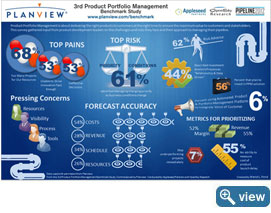How the Product Portfolio Management Benchmark Study Findings Should Inform 2013 Planning
It’s that wonderful time of year again — planning, planning, and more planning. Where are you and your organization in the portfolio planning process at this point?
- Patting ourselves on the back because we are done!
- In the thick of it and taking ibuprofen regularly…
- Oh my, just getting started, thanks for the reminder.
If you manage a product portfolio, it’s likely you have some tough decisions to make for 2013. Given that nearly 70% of organizations reported that they had too many projects for their resources as their top pain point in the 3rd Product Portfolio Management Benchmark Survey (2012)*, it’s vital to establish the right priorities and decisions about how resources will be used to support a product portfolio going into 2013.
But, that begs the question: how do you make the difficult tradeoffs, such as killing underperforming products and funding new ones, and do you have the data to make the decisions?
Taking a look back, we can gain some insight from the Product Portfolio Management (PPM) Benchmark Study and related recommendations. More than 1,000 product development executives and managers have participated in three surveys (conducted in 2009, 2010 and 2012). To refresh your memory on the study, its parameters, findings and recommendations, check out the infographic and download the study today.
Here are some perspectives and recommendations offered in response to the study findings:
Kill Underperformers
First off, you are not alone if your company has a hard time killing underperforming products. Forty-five percent of companies reported that they only kill underperformers “some of the time” and 15% simply don’t stop them once they’ve gone to market. Can companies afford to continue this approach given the top pain point was managing too many projects for their limited resources?
Recommendation 1: Stop underperformers; the planning process is precisely the time to address the process for dealing with underperformers by establishing a centralized location for analytical decision making and visibility, gathering consistent metrics for measurement, and evaluating the entire portfolio with the ultimate goal of directing more resources towards innovation and growth.
Turn on the Lights
The next question is: do you have available and accurate data to make these decisions? All too often, killing a product can be an emotional one or a challenge in certain company cultures. The PPM benchmark studies indicate that many companies either don’t have on-demand access to data or don’t feel the data is accurate. As an example, in the 2012 study, 55% of companies reported that they are unable to measure the cost of a product launch delay. In terms of accuracy, 40% indicated that their expected revenue forecasts were mostly inaccurate and nearly 45% said their schedule forecasts were mostly inaccurate.
Recommendation 2: Turn on the lights and scrub your data to make sure it’s trustworthy. Make sure your dashboard is more than just a pretty picture. It needs to have sufficient data integrity to support decision-making. This will serve your company far beyond annual planning because change is constant. The ability to have on-demand access to accurate data to evaluate different scenarios is needed throughout the year.
Get Started
If you have the data, it’s easy to access on-demand and you can run various scenarios for your portfolio — our prediction for you is that you have a bright year ahead. If you are not there yet, there is no better time than the present to get started and consider what your competition is doing. More than 75% of the PPM study participants in 2012 were planning to acquire or implement an automated PPM solution in the next 12 months.
Recommendation 3: Get started — piecemeal or holistically. Find the most painful part and start to address it. Identify the technology needed, the processes that need updating, and how to go from data in silos to one system to access the truth. Budget for the tools and technology solutions you identify and make it happen.
Drill in on a Microcast about 2013 Planning
I drill further into these recommendations for planning and for 2013 in a new microcast with Carrie Nauyalis. Join us for a frank discussion on planning and portfolio management.
- Access the Microcast, Product Portfolio Management: A Look Back and a Look Ahead
- Read the 3rd Product Portfolio Management Benchmark Study and recommendations
Good luck with your planning efforts and we’ll be back to conduct the 4th benchmark study in Spring, 2013. We want to hear from all of you about the latest trends in PPM.
*All statistics from the 3rd Product Portfolio Management Benchmark Study, conducted by Appleseed Partners and OpenSky Research and sponsored by Planview.

![Product Portfolio Management in the Digital Era [Webinar]](https://blog.planview.com/wp-content/uploads/2017/09/Product-Portfolio-Management-in-the-Digital-Era-750x400.jpg)

![The 2018 Product Portfolio Management Survey Shines A Light on Top Performers [Video]](https://blog.planview.com/wp-content/uploads/2018/06/PDPM-study.gif)

